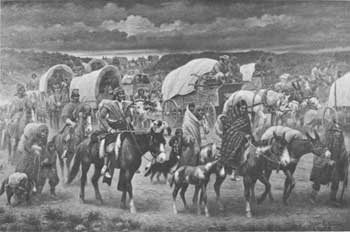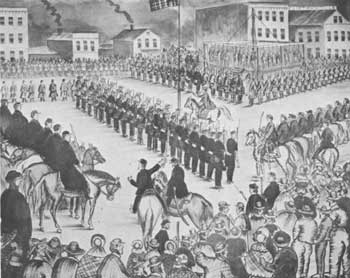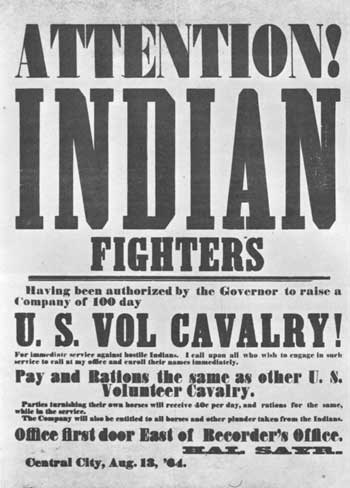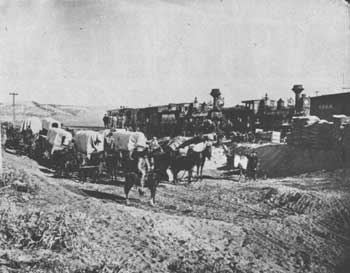





Historical Background
At first the Civil War, draining off the Regulars for service in the East, relaxed the military pressure on the western tribes. The bloody uprising of the Minnesota Sioux in 1862, however, horrified the Nation, and the opening of mining areas in Montana, Idaho, and Arizona disturbed resident tribes. By the closing years of the war, therefore, the Indians found themselves confronted by more soldiers than ever before. Most were Volunteers, enlisted to fight for the Union. Some even were "Galvanized Yankees"—Confederate prisoners clothed in blue to help guard the frontier.
The abundance of troops permitted large-scale offensive operations. In some areas they succeeded. California Volunteers extinguished the last flickers of resistance in the mountains of northern California and ruthlessly dealt with Paiute troubles in Nevada and Shoshoni troubles in Utah. Other Californians, under Gen. James H. Carleton, joined with New Mexican troops to defeat the Mescalero Apaches and to subjugate the powerful Navajos. Both groups were confined on an inhospitable reservation, Bosque Redondo, on the Pecos River of eastern New Mexico. The Mescaleros fled in 1865. For the Navajos the experience proved shattering; allowed to return to their homeland in 1868, they never again challenged U.S. rule by force of arms.
 |
| Robert Lindneux's dramatic version of the Trail of Tears captures the poignancy and suffering of the forced removal of the Cherokees from Southeastern United States to Indian Territory. (Woolaroc Museum) |
Elsewhere the operations of the Volunteers only intensified the spirit of resistance. Such was the case with the Northern Paiutes, or Snakes, of eastern Oregon and western Idaho, and with the Western Apaches of Arizona, against whom General Carleton failed as dramatically as he had succeeded against the Navajos. So, too, with the Sioux. After suppressing the Minnesota outbreak of 1862, the next year Gen. Henry Hastings Sibley led a large column against the Sioux of Dakota, while Gen. Alfred Sully and an other column marched up the Missouri River to cooperate. Again in 1864 and 1865, Sully, aided by expeditions from Minnesota, continued the offensive. And in 1865 still other columns, under Gen. Patrick E. Connor, moved into Sioux country from bases on the Platte. Despite victories at Big Mound, Dead Buffalo Lake, Stony Lake, Whitestone Hill, Killdeer Mountain, and Tongue River, these expeditions only provoked more determined opposition. And to the south, at Sand Creek, Colo., other Volunteers set off unprecedented hostility. Col. John M. Chivington's barbarous attack in November 1864 on Black Kettle's Cheyennes, who thought they were under military protection, spread anger and distrust among all the Plains tribes and led to a major uprising.
 |
| The 1862 uprising of the Santee Sioux in Minnesota ended in defeat. In December the Army publicly executed 38 warriors in Mankato, recorded in this panorama by John Stevens. (Minnesota Historical Society) |
 |
| Emotions peaked and violence reigned on both sides during the Colorado hostilities in 1864. This poster promises to reward recruits with "all horses and other plunder taken from the Indians." (Colorado Historical Society) |
 |
| The extension of the railroad network westward, facilitating settlement and enhancing Army mobility, hastened the end of the Indian wars. Union Pacific supply trains at the end of the track near present Archer, Wyo. (photo by A. J. Russell, Union Pacific Railroad Museum Collection) |
 |
 |
http://www.cr.nps.gov/history/online_books/soldier-brave/intro5.htm
Last Updated: 19-Aug-2005